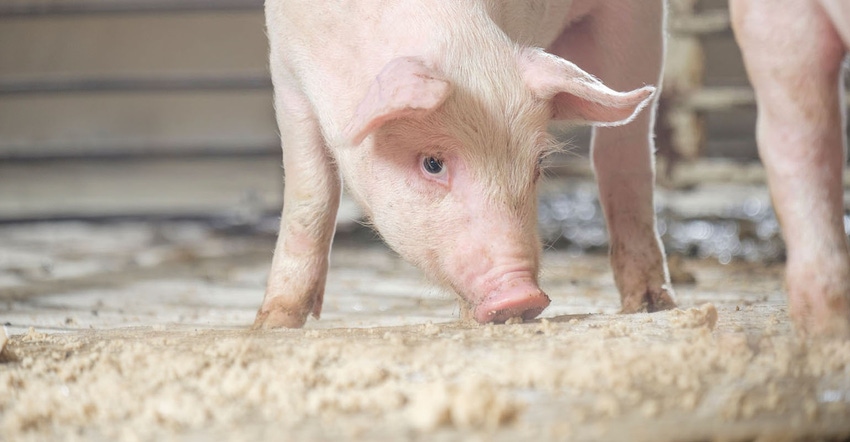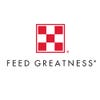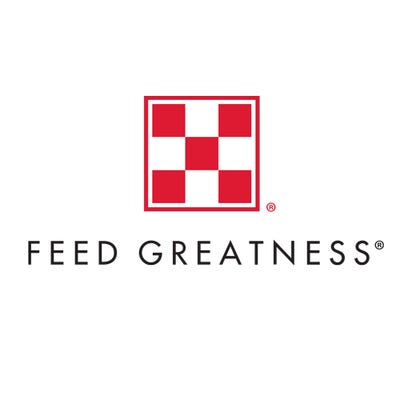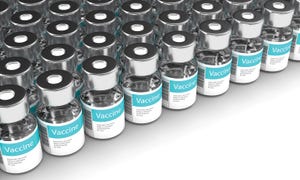Put weaned pigs on the feed intake fast track
Increasing feed intake for your nursey pigs is essential for optimal growth, weight gain and gut function.
May 15, 2023

Sponsored Content
By: Erin Bryan, Ph.D., swine nutritionist with Purina Animal Nutrition
End-of-nursery weights are the strongest predictor of finishing weights.1 Feed intake in the early nursery phase is closely tied to nursery performance, so how a pig responds to its first dry feed sets the pace for performance through finishing.
Weaned pigs need to eat multiple meals per day to consume enough nutrients for optimal growth, weight gain and gut function. Yet, on average, feed intake during the first 3-4 days after weaning is too low to meet the pig’s energy requirements for maintenance, let alone growth.2 This is due to multiple stressors on the pig, such as removal from the sow, transportation to the nursery and introduction to a new environment.
Reduced feed intake can also lead to a breakdown in the intestinal lining, creating a poor environment for beneficial microbes in the intestine and opening the door to illness. A sick pig’s immune system pulls energy from growth and maintenance to combat ailments. Even if the pig doesn’t get sick, poor gut function can impair appetite and reduce feed consumption, creating a downward spiral.
So, how do you get nursery pigs to return to the feeder for the nutrition they need? Here are three tips:
1. Appeal to their sense of taste and smell
Pigs have 50 to 60% more taste buds and nerve cells to collect and process flavors and odors than humans.1,3 These senses are a critical component of the pigs’ success. Before weaning, instinctual responses to the smell of the sow drove the young pig to seek food immediately after farrowing. Once latched, components of the sow’s milk triggered the urge to continue eating. Called imprinting, this sensory-driven instinct can be used to encourage repeat feeding in the nursery.
Offering a creep feed during this imprinting period can help set the pig up for success in the nursery. Pigs that consume creep feed visit the feeder more quickly and more often after weaning, resulting in a higher feed intake and rate of gain.4 You can further leverage this familiarity by combining the right ingredients with Intake Modifying Technology® to create a highly palatable starter feed reminiscent of the creep feed offered during the imprinting period. This can drive consumption in newly weaned pigs, even if they’re unfamiliar with the feed source.
2. Consider mat training
Mat feeding teaches nursery pigs to continually return to the feeder through a cyclical process – feed is placed on the mat, pigs get up and eat, they return to their comfort zone and the process is repeated. This is ideal for nursery pigs because pigs are social creatures and naturally eat in groups. Placing feed on mats initiates pen activity, which can lead to increased feed intake by encouraging repeat feeding.
Development of this habit has been reported to help reduce removal rate4, likely by teaching poor eaters how to feed.6 Mat training also helps you identify these poor eaters – the ones that don’t get up when you put feed down. You can respond and prevent potential challenges as the pigs grow and develop.
Mat feed pigs 4-6 times per day during the first 3-7 days post-weaning for best results. Provide 0.4 square feet of mat per pig, and sprinkle 1 pound of feed or feed supplement per 40 pigs at each feeding.
3. Don’t forget the importance of H2O
It can take as long as 36 hours for 85% of newly weaned pigs to find water. Pig feed intake is strongly correlated to water intake5 – meaning that pigs with higher water intake generally have higher feed intake as well. This translates to better performance in the nursery.
One of the most important tools to support early water intake is drinker management. Whether using nipple or bowl drinkers, be sure to set them to trickle water for at least a day after pigs arrive. This will make it easier for pigs to locate the waterer more quickly upon arrival. Drinker height is also important – adjust drinkers so the nipple is the same height as the average pig’s shoulder. 6
Supplemental electrolytes, vitamins and flavors can help improve pig water intake immediately post-weaning. Electrolytes provide sodium, chloride, magnesium, vitamins and pH acidifiers. These nutrients help balance a pig’s digestive system and keep them drinking and eating.
Connect with your local Purina® representative to learn more about nutritional tools and management practices and recommended nursery feed programs to encourage feed intake and support strong starts during this important phase of life.
1Summation of Purina Animal Nutrition trials: PS1041, PS1035, WF006, WF007, FT142N-15 and PMI Nursery-Grower Transition Pak research (slide 17 in R D Data for PtoP)
2Le Dividich, J. and Seve, B. 2001. Energy requirements of the young pig. In: Varley, M.A. and Wiseman, J. (eds). The weaner pig: nutrition and management. CAB International, United Kingdom, pp. 17-44.
3King, R.H. and Pluske, J.R. 2003. Nutritional management of the pig in preparation for weaning. In: Pluske, J.R., LeDividich, J. and Verstegen, M.W.A. (eds). Weaning the pig. Concepts and consequences. Wageningen Academic Publishers, Wageningen, the Netherlands, pp. 37-52.
4Bruininx, E. M. A. M, et al. 2002. Effect of creep feed consumption on individual feed intake characteristics and performance of group-housed weanling pigs. J. Anim. Sci. 80: 1413-1418. Doi: 10.2527/2002.8061413x
4Wensley, M. R., et al. 2022. Effects of mat feeding on the growth performance, removal, and mortality of pigs after weaning. J. Anim. Sci. 100: skac344. Doi: 10.1093/jas/skac344
5Da Silva, K., et al. 2020. Influence of flavored drinking water on voluntary intake and performance of nursing and post-weaning piglets.
6Goodband, B., et al. 2006. Strategies for feeding weaned pigs. In: Proc. London Swine Conf., London, ON, Canada. p. 75-85.
About the Author(s)
You May Also Like





